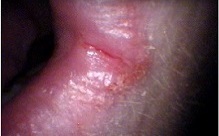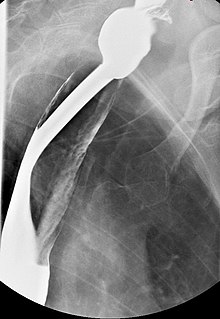| Plummer–Vinson syndrome | |
|---|---|
| Other names |
|
 | |
| Angular stomatitis | |
| Specialty | Gastroenterology, Hematology |
| Symptoms | Dysphagia, iron-deficiency anemia, glossitis, cheilosis, esophageal webs |
| Complications | Esophageal cancer, pharyngeal cancer |
| Usual onset | Typically in perimenopausal women |
| Duration | Chronic, but treatable |
| Causes | Iron deficiency |
| Risk factors | Poor nutritional status, particularly iron deficiency |
| Diagnostic method | Clinical evaluation, esophagogastroduodenoscopy, blood tests (for iron deficiency) |
| Prevention | Adequate iron intake, monitoring at-risk individuals |
| Treatment | Iron supplementation, mechanical dilation of the esophagus |
| Medication | Iron supplements |
| Prognosis | Generally good with treatment |
| Frequency | Rare |
Plummer–Vinson syndrome (also known as Paterson–Kelly syndrome or Paterson–Brown-Kelly syndrome in the UK) is a rare disease characterized by dysphagia (difficulty swallowing), iron-deficiency anemia, glossitis (inflammation of the tongue), cheilosis (cracking at the corners of the mouth), and esophageal webs (thin membranes in the esophagus that can cause obstruction). Treatment with iron supplementation and mechanical widening of the esophagus generally leads to excellent outcomes.
While exact epidemiological data are lacking, Plummer–Vinson syndrome has become extremely rare. The reduction in prevalence has been hypothesized to result from improvements in nutritional status and iron availability in countries where the syndrome was previously more common. The syndrome generally occurs in perimenopausal women. Identification and follow-up of affected individuals are important due to the increased risk of squamous cell carcinoma of the esophagus and pharynx.
Presentation
Patients with Plummer–Vinson syndrome often experience a burning sensation in the tongue and oral mucosa, and atrophy of the lingual papillae results in a smooth, shiny, red dorsum of the tongue. Common symptoms include:
- Dysphagia (difficulty swallowing)
- Pain
- Weakness
- Odynophagia (painful swallowing)
- Atrophic glossitis (smooth tongue)
- Angular cheilitis (inflammation and cracking at the corners of the mouth)
- Koilonychia (abnormally thin or spoon-shaped nails)
- Splenomegaly (enlarged spleen)
- Upper esophageal webs (located in the post-cricoid region, contrasting with Schatzki rings found at the lower end of the esophagus)
Serial contrast gastrointestinal radiography or upper-gastrointestinal endoscopy may reveal the presence of esophageal webs. Blood tests typically show hypochromic microcytic anemia, consistent with iron-deficiency anemia. A biopsy of the affected mucosa usually reveals epithelial atrophy (shrinking) and varying degrees of submucosal chronic inflammation. Epithelial atypia or dysplasia may also be present. In some cases, the syndrome may manifest as post-cricoid malignancy, which can be detected by the absence of laryngeal crepitus. Normally, laryngeal crepitus is produced when the cricoid cartilage rubs against the vertebrae.
Causes
The cause of Plummer–Vinson syndrome is unknown; however, both genetic factors and nutritional deficiencies may play a role. The syndrome is more common in women, particularly those in middle age, with a peak incidence occurring in individuals over 50 years of age.
Diagnosis
The following clinical presentations may be indicative of Plummer–Vinson syndrome and may be used in its diagnosis:
- Dizziness
- Pallor of the conjunctiva and face
- Erythematous oral mucosa with a burning sensation
- Breathlessness
- Atrophic, smooth tongue
- Peripheral rhagades (cracks or fissures) around the oral cavity
The following tests are helpful in the diagnosis of Plummer–Vinson syndrome:
Lab tests
Complete blood cell counts, peripheral blood smears, and iron studies (e.g., serum iron, total iron-binding capacity, ferritin, and saturation percentage) are essential for confirming iron deficiency, with or without the presence of hypochromic microcytic anemia.
Imaging
Barium esophagography and videofluoroscopy can aid in detecting esophageal webs. Esophagogastroduodenoscopy allows for the visual confirmation of these webs, which are caused by subepithelial fibrosis.


Prevention
Maintaining good nutrition with adequate iron intake may help prevent this disorder. A balanced diet, combined with regular exercise, is also recommended.
Treatment

Treatment for Plummer–Vinson syndrome primarily focuses on correcting the underlying iron-deficiency anemia. Patients should receive iron supplementation as part of their diet, which may alleviate symptoms such as dysphagia and pain. If symptoms persist, the esophageal web can be dilated using esophageal bougies during upper endoscopy, which allows for normal swallowing and the passage of food. However, there is a risk of perforation of the esophagus with the use of dilators for treatment.
Prognosis
Patients generally respond well to treatment. Iron supplementation usually resolves the anemia and corrects the glossodynia (tongue pain). Plummer–Vinson syndrome is recognized as a risk factor for developing squamous cell carcinoma of the oral cavity, esophagus, and hypopharynx. The risk of esophageal squamous cell carcinoma is also increased, and therefore, the syndrome is considered a premalignant condition.
Epidemiology
Plummer–Vinson syndrome (PVS) is an extremely rare condition, and its exact prevalence remains unknown. While it is becoming less common in developed countries, the condition is increasingly found in developing regions, particularly in Asia. However, it is very rarely observed in African countries, despite the relatively high prevalence of iron deficiency there.
History
The disease is named after two Americans working at the Mayo Clinic—physician Henry Stanley Plummer and surgeon Porter Paisley Vinson. In the UK, it is known as Paterson–Kelly or Paterson–Brown-Kelly syndrome, named after Derek Brown-Kelly and Donald Ross Paterson, who independently described the syndrome in 1919. Despite this, "Plummer–Vinson syndrome" remains the most commonly used name.
See also
References
- ^ Novacek G, Gottfried (2006). "Plummer-Vinson syndrome". Orphanet Journal of Rare Diseases. 1: 36. doi:10.1186/1750-1172-1-36. PMC 1586011. PMID 16978405.
- ^ Verma, Sandeep; Mukherjee, Sandeep (2023), "Plummer-Vinson Syndrome", StatPearls, Treasure Island (FL): StatPearls Publishing, PMID 30855890, retrieved 2023-11-08
- Sabiston 18th edition, p. 1078.
- "Plummer-Vinson syndrome: MedlinePlus Medical Encyclopedia". 2011.
- Enomoto M, Kohmoto M, Arafa UA, et al. (2007). "Plummer-Vinson syndrome successfully treated by endoscopic dilatation". Journal of Gastroenterology and Hepatology. 22 (12): 2348–51. doi:10.1111/j.1440-1746.2006.03430.x. PMID 18031398. S2CID 33777667.
- "Plummer-Vinson Syndrome". PubMed Health. Retrieved 31 January 2012.
- ^ Goel, A; Bakshi, SS; Soni, N; Chhavi, N (2017). "Iron deficiency anemia and Plummer-Vinson syndrome: current insights". Journal of Blood Medicine. 8: 175–184. doi:10.2147/JBM.S127801. PMC 5655134. PMID 29089792.
- synd/1777 at Who Named It?
- Plummer, H.S. (1912). "Diffuse dilatation of the esophagus without anatomic stenosis (cardiospasm). A report of ninety-one cases". Journal of the American Medical Association. 58: 2013–2015. doi:10.1001/jama.1912.04260060366003.
- Vinson, P.P. (1919). "A case of cardiospasm with dilatation and angulation of the esophagus". Medical Clinics of North America. 3. Philadelphia, PA: 623–627.
External links
| Classification | D |
|---|---|
| External resources |
| Diseases of the human digestive system | |||||||||||
|---|---|---|---|---|---|---|---|---|---|---|---|
| Upper GI tract |
| ||||||||||
| Lower GI tract Enteropathy |
| ||||||||||
| GI bleeding | |||||||||||
| Accessory |
| ||||||||||
| Other |
| ||||||||||